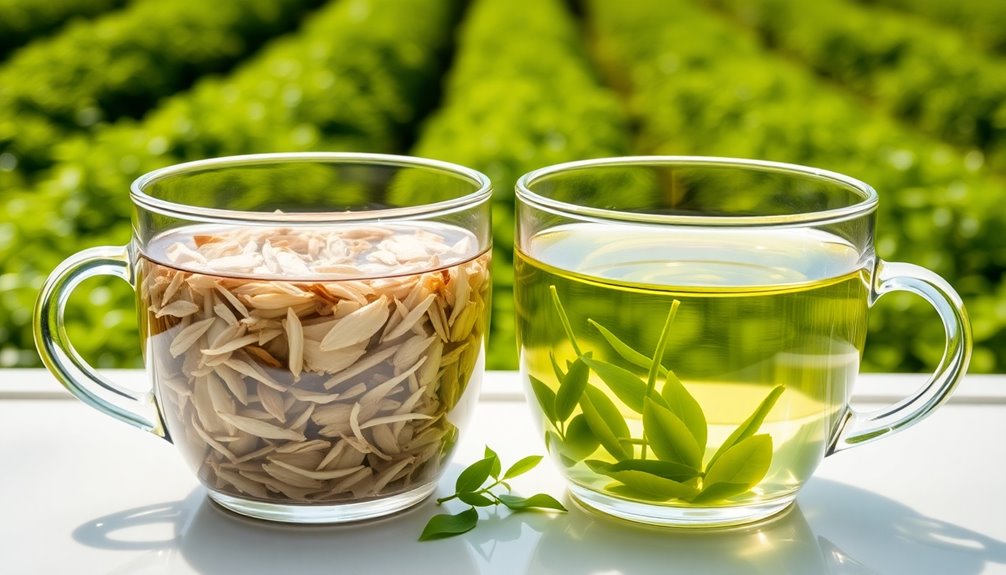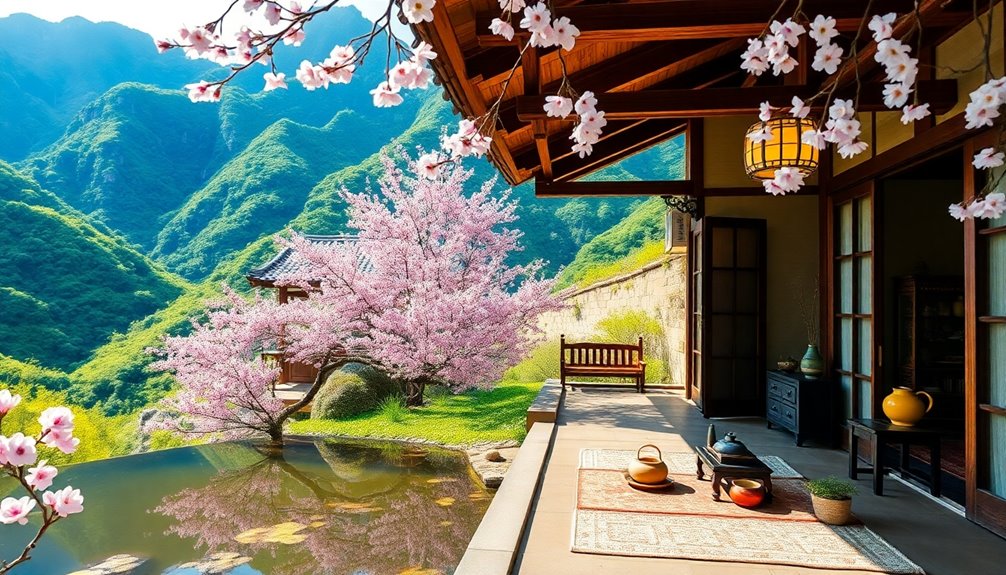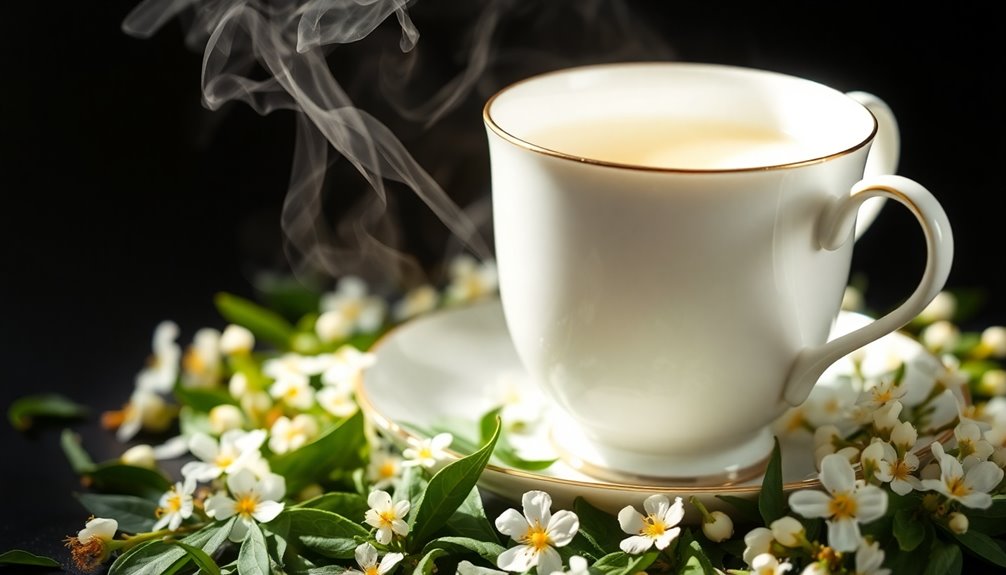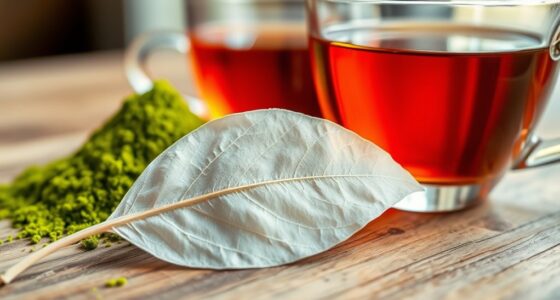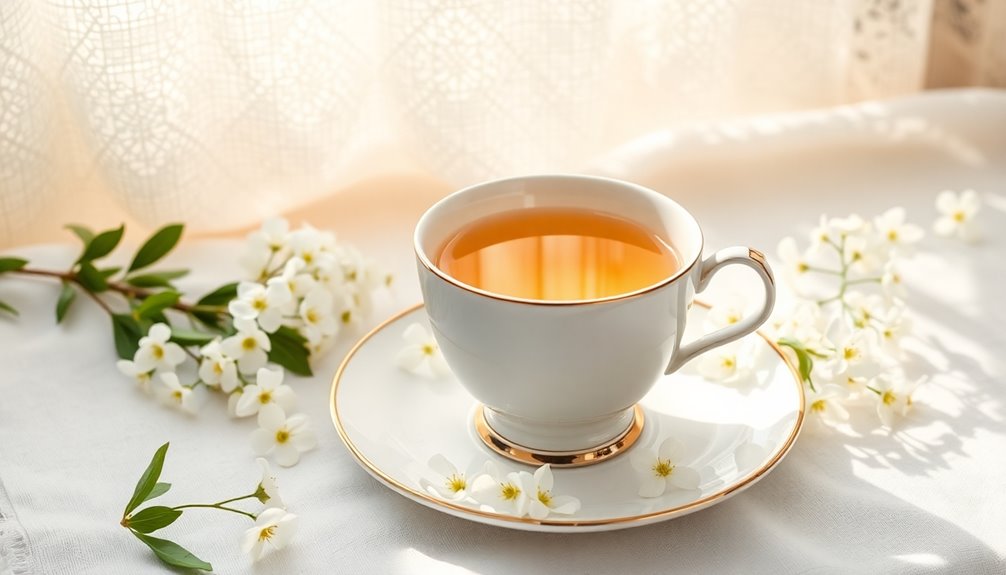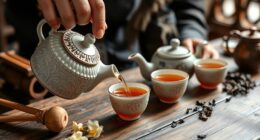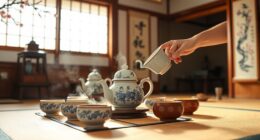White tea and green tea both come from the same plant, Camellia sinensis, but they have key differences. White tea, mostly from Fujian, China, is made from young leaves and buds with minimal processing. It's sweeter and contains more caffeine, roughly 40 mg per serving. Green tea, popular in Japan and China, is steamed or pan-fried and has a slightly grassy taste, with about 30-50 mg of caffeine. Both teas offer health benefits, like protecting your skin and providing antioxidants. If you're curious about their unique brewing methods and cultural roles, you'll find even more interesting facts ahead!
Key Takeaways
- White tea is minimally processed and primarily sourced from Fujian province, while green tea is pan-fried or steamed, originating in China and Japan.
- White tea is harvested in spring and early summer, focusing on young leaves, whereas green tea can be harvested multiple times throughout the year.
- White tea generally contains 6-55 mg of caffeine per serving, averaging around 40 mg, while green tea contains about 30-50 mg of caffeine.
- White tea offers antioxidants that preserve collagen, reducing wrinkles, while green tea's catechins help reduce inflammation and redness in the skin.
- Culturally, white tea is linked to traditional Chinese ceremonies, while green tea holds significance in Japanese rituals, reflecting different brewing practices.
Introduction
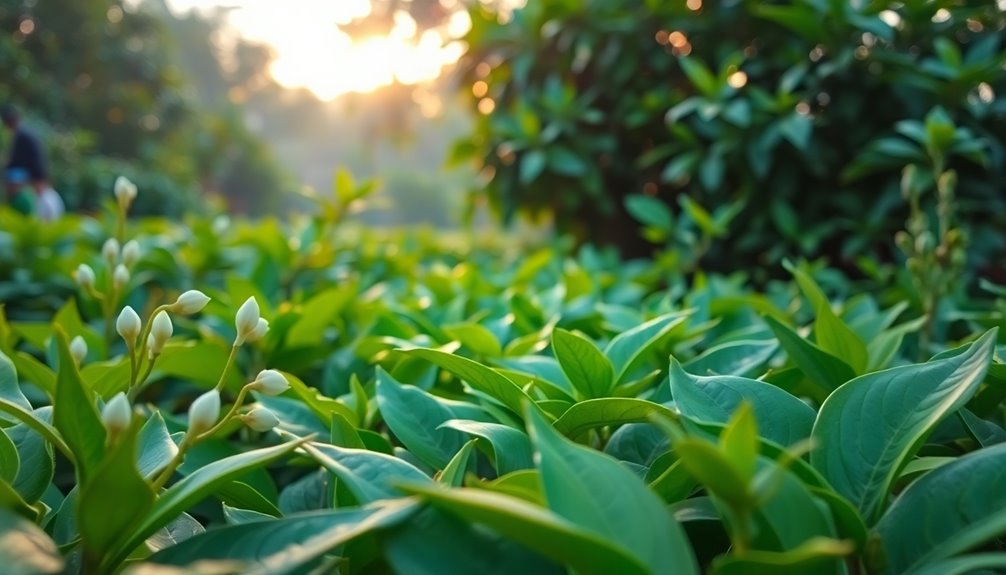
When you sip a cup of tea, you mightn't realize that two popular varieties—white tea and green tea—come from the same plant, Camellia sinensis. Both teas have unique qualities, making them loved by many.
White tea primarily hails from China, especially the Fujian province, while green tea has roots in China and Japan, spreading to other Asian countries.
The key difference lies in their processing. White tea is minimally processed, using air-drying methods to preserve its delicate flavor, while green tea is often pan-fried or steamed to stop oxidation. This difference affects their flavor profiles: white tea offers mild, fruity notes, whereas green tea presents robust, grassy flavors.
You might also notice a difference in caffeine levels. Generally, white tea contains less caffeine compared to green tea, though this can vary based on growing conditions and tea variety.
Both types of tea are rich in antioxidants, leading to various health benefits. As tea enthusiasts grow more curious about white tea, it's becoming increasingly popular.
Tea Leaf Harvesting Techniques
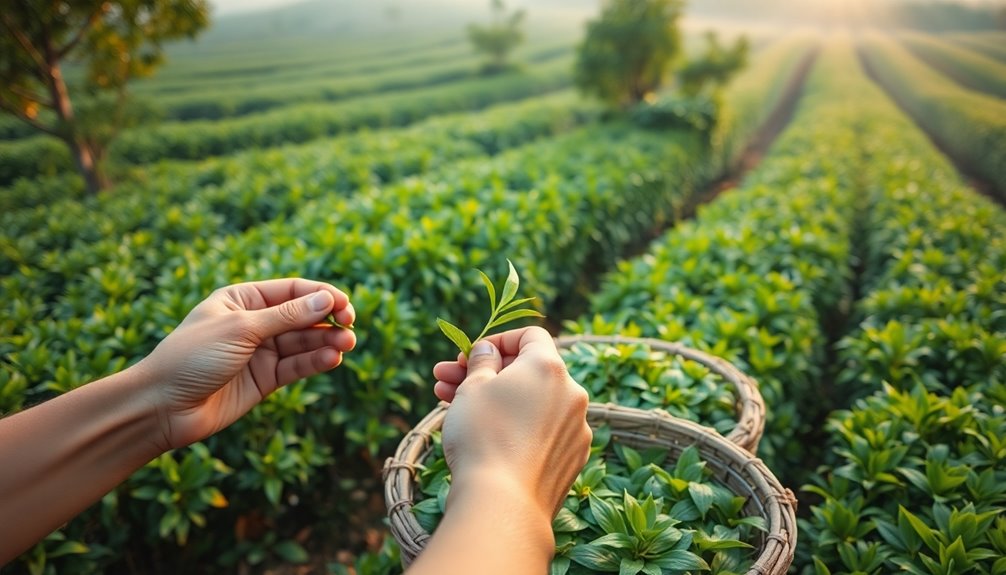
Although both white tea and green tea originate from the same Camellia sinensis plant, their harvesting techniques differ significantly.
White tea is picked primarily in the spring and early summer, focusing on the young leaves and buds. For the highest quality, like Silver Needle, the buds are harvested while still covered in fine silvery hairs.
On the other hand, green tea can be harvested multiple times throughout the year, even in autumn, allowing for more flexibility.
The harvesting methods for white tea involve minimal handling to keep the delicate leaves intact. This gentle approach helps preserve the tea's natural flavor and quality.
In contrast, green tea leaves are usually picked when they're young but undergo more extensive processing methods. These include rolling and steaming, which enhance their flavor and prevent oxidation.
Both types of tea require skilled labor for precise plucking. The timing of the harvest is crucial, as it greatly influences the final flavor and quality of each tea.
Understanding these differences in harvesting techniques can help you appreciate the unique qualities of white tea and green tea even more!
Caffeine Levels Vary Significantly
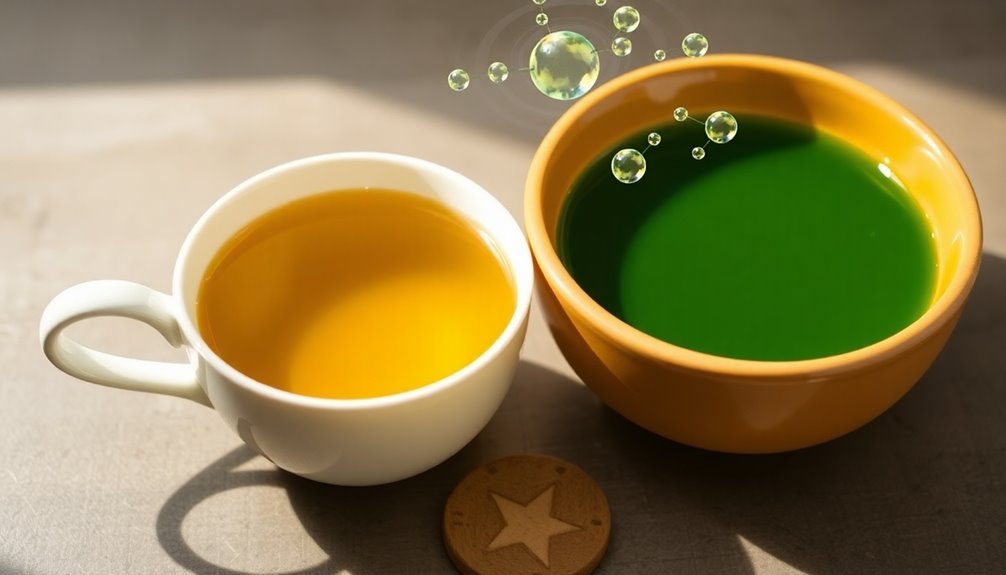
How do caffeine levels in white tea and green tea compare?
When it comes to caffeine, white tea generally contains between 6-55 mg of caffeine per serving, with an average of around 40 mg. On the other hand, green tea usually has about 30-50 mg of caffeine.
A study revealed that white tea averages 28.584 mg of caffeine per 100 ml, while green tea averages 26.445 mg for the same amount.
You'll notice that caffeine levels can vary quite a bit based on the specific tea variety, growing conditions, and harvesting methods. For example, younger leaves often have more caffeine, so certain white teas could have higher caffeine than some green teas.
Both white and green teas are great choices if you're looking for lower caffeine compared to coffee, which typically has around 100 mg per cup.
So, when you're deciding between tea vs. white tea, remember that white tea's caffeine levels can be higher than green tea, but both offer a gentler boost than your morning coffee.
Enjoy experimenting with both types and see which one you prefer!
Health Benefits for Skin
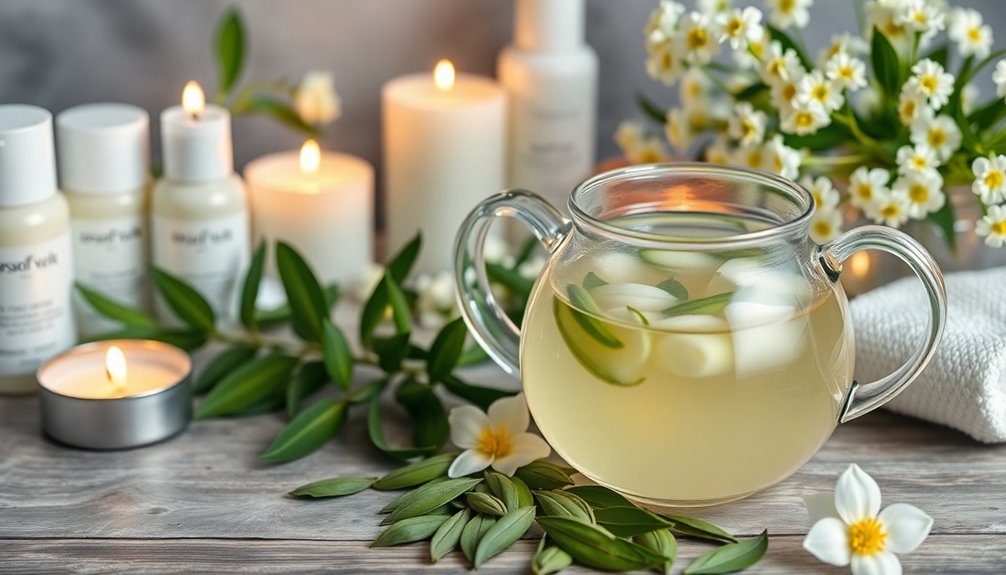
Both white tea and green tea offer impressive health benefits for your skin, thanks to their rich antioxidant content. These antioxidants help protect your skin cells from damage caused by UV rays and pollution.
If you're looking for anti-aging properties, white tea is a great choice. Its high levels of antioxidants can preserve collagen and elastin in your skin, reducing the appearance of wrinkles.
On the other hand, green tea is packed with catechins, which can reduce inflammation and redness. This makes green tea especially helpful for those dealing with acne or rosacea. By drinking either tea regularly, you may promote a clearer complexion.
Their antioxidant properties can aid in detoxification and improve overall skin health.
Moreover, white tea's antibacterial properties help combat skin infections and promote good skin hygiene.
Cultural Perceptions of Tea
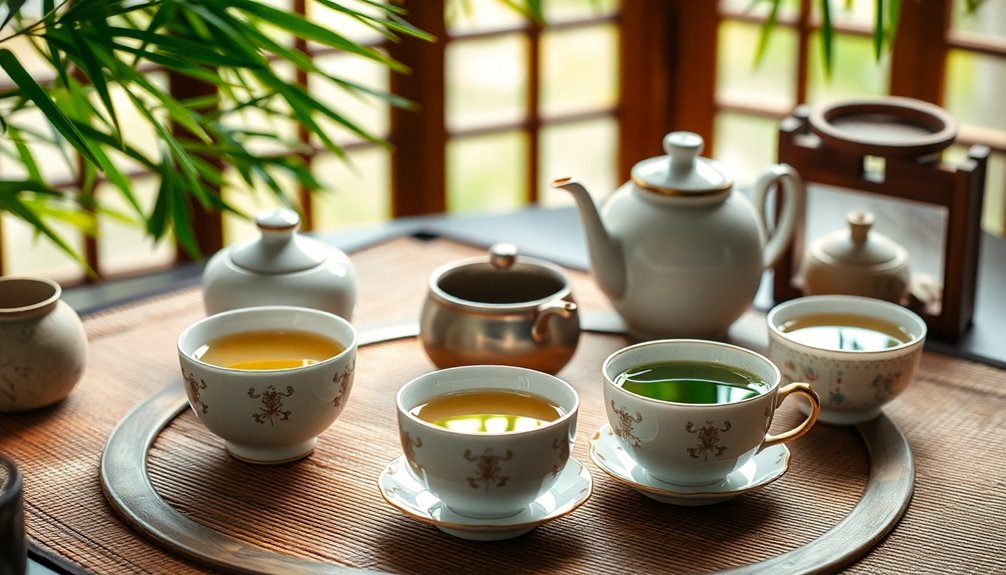
Tea holds a special place in various cultures, each with its unique customs and significance. White tea is often linked to traditional Chinese tea ceremonies, showcasing its historical roots in the Fujian province. These ceremonies highlight the importance of ritual and mindfulness, making every sip a moment of appreciation.
On the other hand, green tea shines in Japanese culture, especially during the Japanese tea ceremony (chanoyu). This practice emphasizes aesthetics and careful preparation, turning tea drinking into an art form.
While white tea was once a luxury for Chinese aristocracy, today it's popular among tea enthusiasts everywhere. You can find various brewing techniques for both teas that reflect their cultural practices. For instance, green tea is often enjoyed in casual settings, making it a favorite for everyday relaxation.
In contrast, white tea is typically reserved for more formal gatherings, where it's presented with elegance.
Understanding these cultural perceptions can enhance your tea experience. Whether you're savoring white tea or green tea, you're partaking in a rich tapestry of traditions that span the globe.
Practical Applications
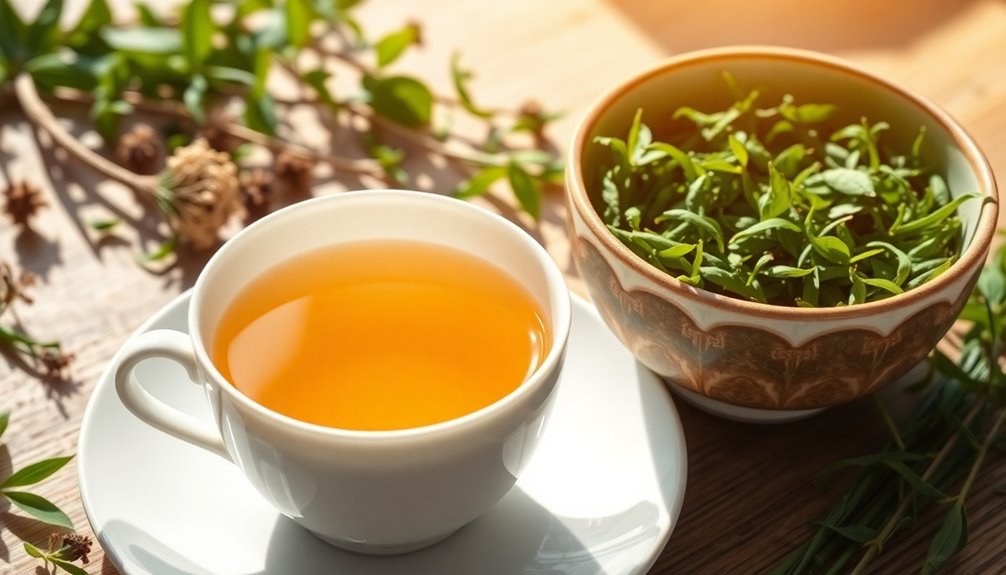
Exploring the cultural significance of white and green tea sets the stage for practical applications that can elevate your brewing experience.
When you prepare white tea, heat your water to about 180°F and steep for 2-3 minutes. This helps with flavor extraction and lets you enjoy multiple infusions from the same leaves.
Green tea, on the other hand, requires a lower brewing temperature—between 140-175°F—and a steeping time of 1-4 minutes. Different varieties may need unique techniques to avoid bitterness.
You'll find that white tea has a delicate, fruity flavor, while green tea offers a more robust, grassy taste. To get the most out of these teas, try them without sugar or milk. Both are naturally low in calories and packed with antioxidants, enhancing their health benefits.
Consider the time of day, too! Green tea, with its slightly higher caffeine content, makes a great morning boost, while white tea is perfect for a milder afternoon choice.
Experimenting with steeping times and temperatures can truly enrich your tea experience, making every cup a delightful moment. Enjoy your brewing journey!
Frequently Asked Questions
Is White Tea Better for You Than Green Tea?
Whether white tea's better for you depends on your health goals. If you seek higher antioxidants and skin benefits, white tea's great. If you're focused on weight loss, green tea might be your best choice.
What Is the Healthiest Tea?
When choosing the healthiest tea, consider your goals. Both white and green teas offer unique benefits, like antioxidants and metabolism boosts. You'll find that regular consumption supports overall well-being and reduces chronic disease risks.
Is It Safe to Drink White Tea Every Day?
Yes, it's generally safe for you to drink white tea every day. Its low caffeine levels and high antioxidants can benefit your skin and overall health, but watch your intake if you're sensitive to caffeine.
Does White Tea Have Caffeine?
Yes, white tea does have caffeine. Depending on the type and age of the leaves, it can contain 6-55 mg per serving, offering a mild energy boost without the jitters associated with coffee.
Conclusion
Now that you know the differences between white tea and green tea, you can choose the one that suits your taste and needs. Remember, both types of tea have unique benefits, from their harvesting techniques to their health perks for your skin. Whether you're looking for a gentle boost of caffeine or a refreshing drink, both options are great. So, brew a cup, enjoy the flavors, and feel good about your choice! Happy sipping!

